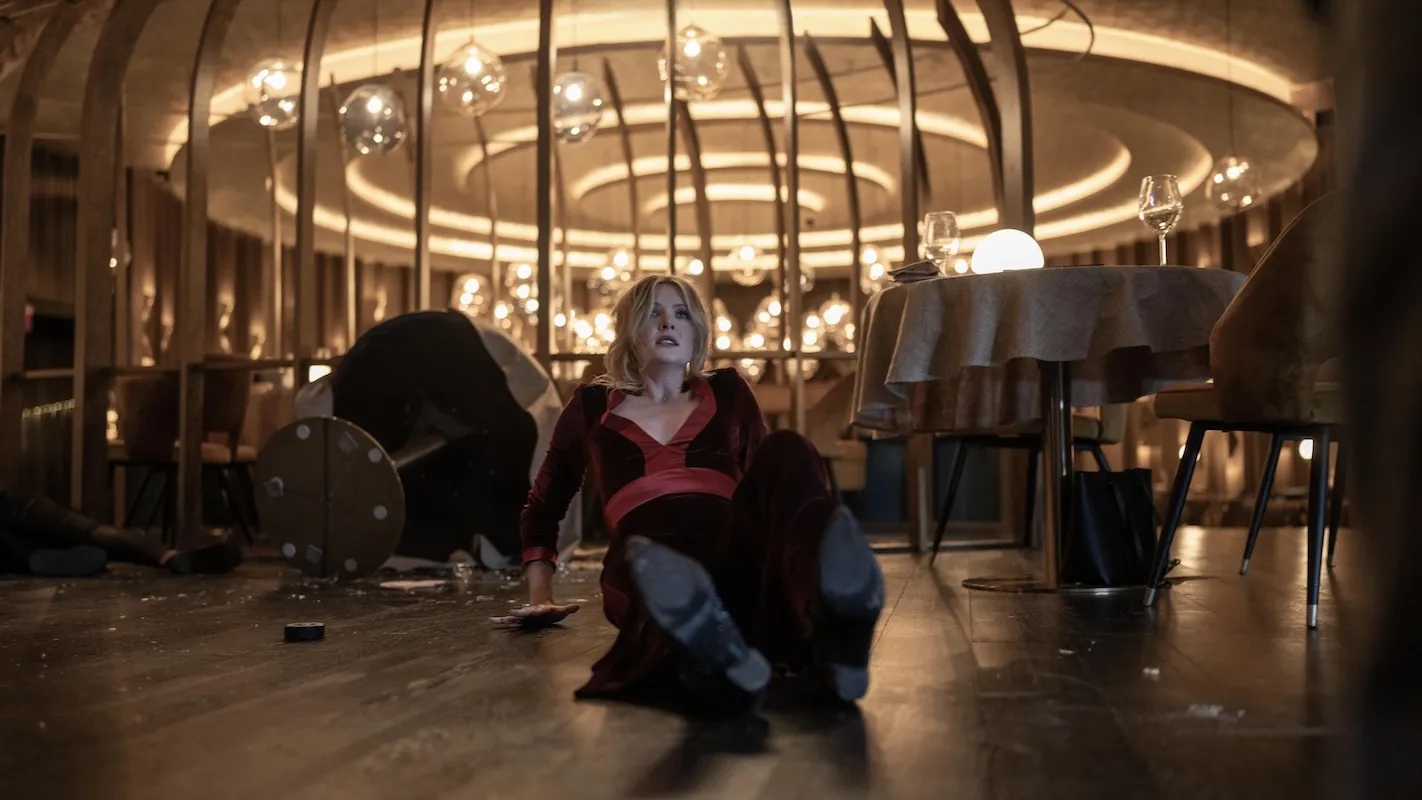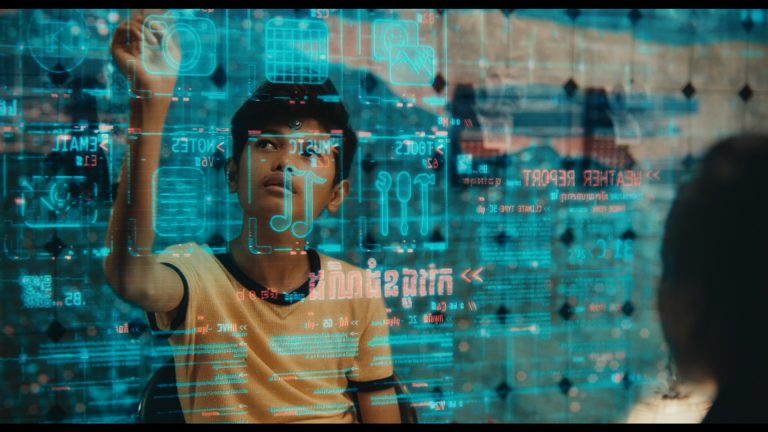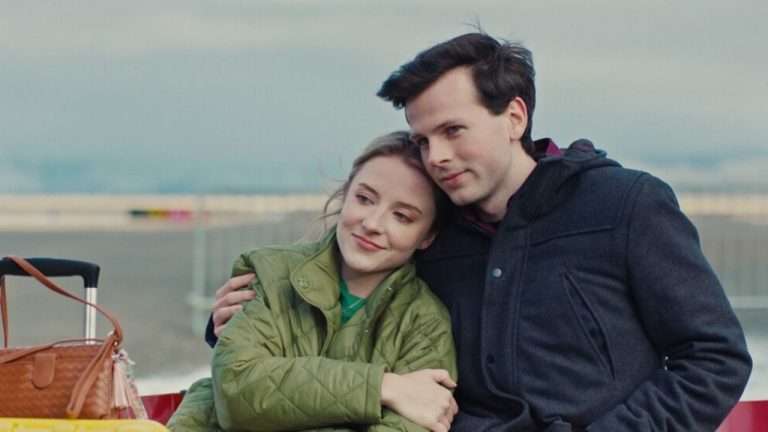There are few ways for a film to date itself quite like a premise entirely reliant on a piece of trendy technology, Try as Apple might to deny it, there’s simply no way of knowing whether or not the famed AirDrop feature will constitute a lasting part of our everyday experiences in the same manner as the phones on which it’s used. Not to suggest that Christopher Landon’s “Drop” is in any way framed like a shameless ad for the iPhone feature. On the contrary, the particular use of the program in this film may very well leave Tim Cook shaking in his turtleneck.
Of course, this would be ignoring the fact that “Drop” is, in premise, not all that dissimilar to an entirely different confined thriller made over a decade ago—switch its high-rise restaurant setting for an airplane, its AirDrop gimmick for a few simple anonymous texts, and its petrified blonde for a glum brunette by the name of Liam Neeson, and you could call the film “Non-Stop.” Regardless of the recurring pieces adapting to the new techy trends, however, one thing that surely risks dating Landon’s own 2025 film is its subservience to the specific tonal balance of humor and weighty themes that have proven themselves more than a passing fad.
For all this talk about “dating,” it’s fitting enough that “Drop” centers itself on an actual date between two longtime social app prospects at their inaugural in-person meetup. Violet (Meghann Fahy) especially needs this experience, if not only for the prospect of finally getting out of the house after years of solitarily raising her only son, then for the symbolic leap taken after the scarring abuse from her relationship with the boy’s father, long dead under traumatic circumstances. A fancy dinner with the affable and ever-accommodating Henry (Brandon Sklenar) may be exactly what Violet needs.
If her first-date jitters aren’t enough to set her off-course, though, then perhaps a series of anonymous AirDrops coming from within the isolated restaurant will do the trick. Rather than unsolicited pictures (as is jokingly hypothesized early on as an ice-breaker between the two diners), Violet’s phone is on the receiving-end of something far more disturbing: whoever is on the other side of this line—and, consequently, somewhere in this room—has a masked man inside her house, a man ready to kill Violet’s son unless she follows her tormenter’s instructions, and turns the tables of death on the man sitting right in front of her.

Naturally, finding who in the restaurant is dangling the strings is a fool’s errand, as everywhere Violet looks, someone is staring at their phone, the potential mastermind obscured behind an omnipresent mask of rectangular glass (“society,” etc., etc.). “Drop,” like the best films of its ilk, then becomes just as much about the futility of finding the orchestrator as it is about continuously delaying his torturous commands. And while it is here, too, that Landon finds himself borrowing from other playhouses (some tricks will look very familiar to those who recently watched “Non-Stop” director Jaume Collet-Serra’s most recent film “Carry-On”), at least his version maintains some semblance of its own personality as it walks the tightrope.
The personality in question isn’t necessarily a through-and-through benefit, however, as much of Landon’s chosen identity finds itself reliant on some cringe-worthy elements of comedy. A recurring bit with a first-time waiter/aspiring improv artist is about as bearable a bit as that sentence sounds. This proves to be especially cumbersome when “Drop” delves further into the well-intentioned thematic territory of surviving abuse, a through-line that proves admirable if ultimately incongruous with the more lightweight thrills ideal for a film of this precise shade.
Where that personality shines, though, is in Landon’s grasp of his environment, as his angular vision and pronounced usage of stagey lighting cues undercut the stuffiness of the film’s precise, high-end restaurant set design just as much as they prove complementary to it. Every moody, dangling light fixture and every swooping camera movement through the seemingly endless, almost skeletal archway into the restaurant adds to the suffocating atmosphere of a locale designed with the specific intent of curating relaxation.
Even something as deceptively simple as blocking becomes, in a film like “Drop,” a meticulous calculation in order to account for the onscreen texts that compose the ominous threats received through these deathly messages. Landon certainly hasn’t come to any creative solutions regarding the increasingly frequent question of “How do we make texting cinematic?” but if nothing else, his means of doing so—alongside the film’s framing decisions in moments where that empty space is filled with nothing but the terrified emptiness of our protagonist’s thoughts—read like the work of a director making a concerted, if not revelatory, effort to stimulate the screen.
Whether or not AirDropping proves to be a fundamental part of our daily phone usage, or whether some other new feature proves to make this one go the way of the headphone jack, Christopher Landon’s film is not likely to exist as much more than a casual timestamp, itself to be outlived by greater and more ambitious successors down the line. Like its namesake feature, “Drop” is functional, flawed, and ultimately serving a narrow purpose when the call for a few diverting kicks hits that notification tab.




![Hacksaw Ridge [2016] : The Hero of War](https://79468c92.delivery.rocketcdn.me/wp-content/uploads/2017/01/Andrew-Garfield-Hacksaw-Ridge-e1483384758541-768x340.jpg)

![Mank [2020] Netflix Review: An Obsessive Cocktail of Creativity and Politics](https://79468c92.delivery.rocketcdn.me/wp-content/uploads/2020/12/Mank-Netflix-highonfilms-1-768x426.png)

![Kavaludaari [2019] Review – A layered Murder Mystery from the writer of Andhadhun](https://79468c92.delivery.rocketcdn.me/wp-content/uploads/2019/05/Kavaludaari-2019-High-On-Films-768x430.jpeg)
